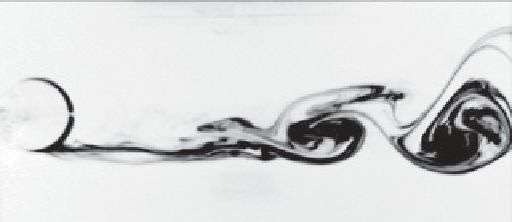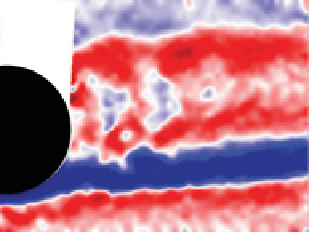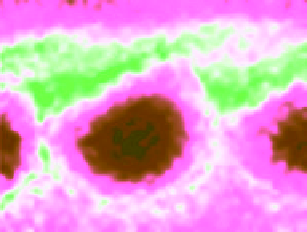Geoscience Reference
In-Depth Information
(a)
(b)
Figure 14.3.
Dye visualization of an anticyclonic vortex street formed in the lee of a translating cylinder in an upper shallow-water
layer at (a)
t
=0and(b)
t
=2
T
0
when Ro
I
= 0.36, Bu = 0.31, and Re = 1100. The fluorescent dye was uniformly painted all
around the cylinder (
D
= 7 cm) and released in the boundary layer during the translation. The turntable rotates clockwise and the
cylinder starts to move at
t
−
6
T
0
.
(a)
(b)
(c)
0.4
0.2
0
-0.2
-0.4
Figure 14.4.
Surface vorticity field of a large-scale wake flow within an upper shallow-water layer at (a)
t
=0,(b)
t
2
T
0
,and
(c)
t
5
T
0
when Ro
I
= 0.19, Bu = 0.11, and Re = 800 [
Perret et al.
, 2006b]. Blue color corresponds to anticyclonic and red to
cyclonic vorticity. The cylinder (
D
= 7 cm) is drawn in black and its shadow in the laser sheet is in white on image (a). For color
detail, please see color plate section.
amplifier, the entire flow being convectively unstable. A
small wave packet perturbation is amplified but propa-
gates downstream in the flow and does not contaminate
the upstream flow. Hence, large-scale anticyclones may
form far downstream, unlike the classical Karman wake.
In this frontal geostrophic regime, the typical radius of the
anticyclone size is controlled by
R
d
, whereas for finite or
large Bu the eddy size scales with the island radius
R
.The
main consequence of the distortion or the disappearance
of the cyclonic street is a strong increase in the Strouhal
number. Indeed, the latter can be three times larger than
the standard value reached in a classical Karman street
when the surface deviation exceeds 10% of the unper-
turbed thickness. According to Figure 14.5, this strong
variation of the Strouhal number is mainly governed by
the relative interface deviation parameter
λ
=Ro
/
Bu
and is weakly affected by the Reynolds number. A similar
increase of the Strouhal number and anticyclonic robust-
ness was also found for the same range of parameters with
the high-resolution numerical model (ROMS) of a surface
intensified wake flow [
Dong et al.
, 2007].
14.5. SUBMESOSCALE VORTEX WAKE
When an oceanic current encounters a small island,
smaller than the local Rossby radius, both the Burger
and island Rossby numbers increase. When the island size
is three or four times smaller than
R
d
, the Burger num-
ber becomes large and the island Rossby number is often
finite. The relation between Ro
I
and the local amplitude
of the vorticity
ζ/f
is not well established and crucially
depends on the dissipation, in other words the Reynolds
number. Nevertheless, in both laboratory experiments and
the ocean, for the most intense structures we generally
get
|
|
≥
2Ro
I
. It is well known that when the rel-
ative vorticity becomes finite,
ζ/f
|
| ∼
1, the rotation
alters the stability of two-dimensional flow with respect
to three-dimensional perturbations. The inertial [
Johnson
,
1963;
Yanase et al.
, 1993], centrifugal [
Kloosterziel and
VanHeijst
, 1991;
Mutabazi et al.
, 1992], or symmetric
[
Hoskins
, 1974;
Haine and Marshall
, 1998] instability may
induce a selective destabilization of anticyclonic vorticity
regions.
ζ/f





















